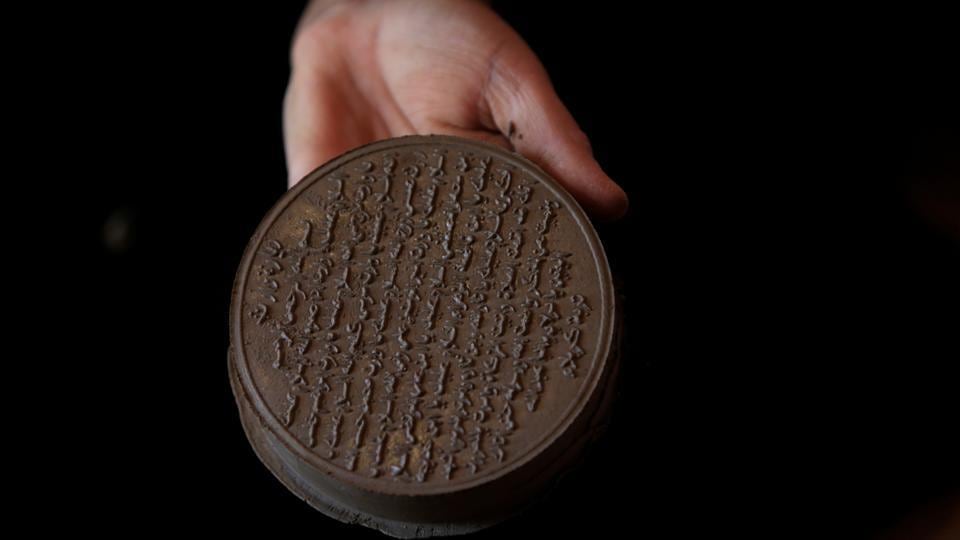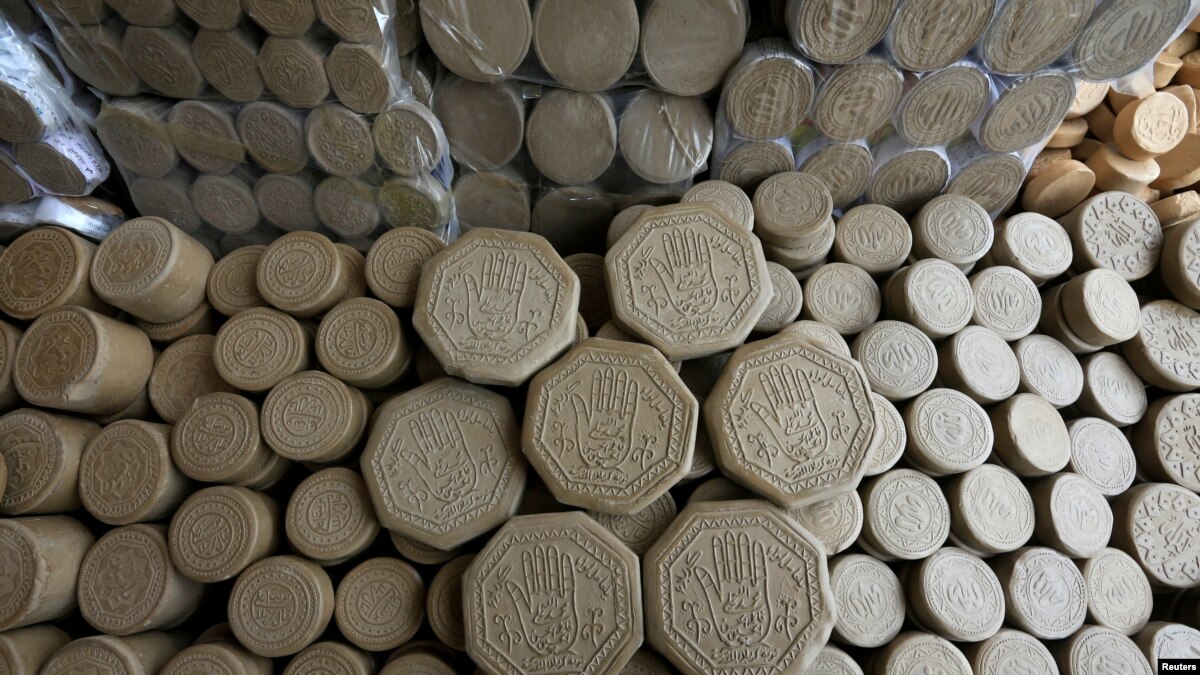
BANI HASYIEMI SHOP macammacam turbah dari ukuran terkecil hingga terbesar turbah various
Turbah (bahasa Arab: تربة, har. 'tanah'), atau mohr (bahasa Persia: مهر, har. 'segel/stempel'), juga disebut sebagai khāk-e shefā (bahasa Persia: خاکِ شِفا, har. 'tanah pengobatan', juga dalam bahasa Urdu) dan sejde gāh (bahasa Persia: سجدہ گاہ, har. 'tempat sujud', juga dalam bahasa Urdu), adalah sebuah lempengan tanah liat dan digunakan saat salat untuk melambangkan.

What is the Turbah prayer stone?
Turbah Karbala (Arabic: تربة کربلاء, lit. 'Soil of Karbala'), or Khāk-e Shifā (Lisan al-Dawat, Persian, and Urdu: خاکِ شِفاء, lit. 'Medicinal Soil'), or "Turbah of Imam Hussain" is the soil taken from Hussain ibn Ali's grave in the city of Karbala. Shia Muslims use it to make turbah and misbaha.

Photos Making Turbah shrine tablets from the soil at Karbala in Iraq Hindustan Times
So they would prostrate on the earth and the marks of mud, for example, would be on their forehead. Or they would prostrate on pebbles and they would feel the heat of the pebbles. They would recognise that prostration would be on that which is natural or that which has come from the earth. Therefore, there was a reference even given to the.

Turbah Safinah Online
Turbah (Arabic: تربة) or muhr (Farsi: مُهر) is a piece of stone or molded clay which Shi'a put their forehead on when prostrating in the prayer. Shi'a believe that turbah is not essential in prostration, and prostrating on the ground, soil, stone, or what grows from the ground (except edible and wearable things) is valid.

BANI HASYIEMI SHOP macammacam turbah dari ukuran terkecil hingga terbesar turbah various
The Shi'ah for a long time have kept this earth with them. Then, fearing that it might be desecrated, they kneaded it into small tablets or pieces, which are now called mohr or Turbah. During prayers we prostrate on it not as a compulsory act but in view of its special nature. Otherwise, when we have no pure soil with us, we prostrate on clean.

"Turbah,” Keping Berkah, Kesembuhan dan Penghidupan Kaum Syiah Pengen Gayaan
A turbah , or mohr , also known as khāk-e shefā and sejde gāh , is a small piece of soil or clay, often a clay tablet, used during salat to symbolize earth. Following the instruction from the Quran, Shia Imam Ja'far al-Sadiq stated that "prostration must be performed on pure earth or what grows on it, provided that it is not eaten or worn." For example, prostration on paper is permissible.

Turbah Clay Turbah tablets that Shia Muslim used in prayin… Flickr
Shaikh Uthman al Khamees explains how and why shias invented the bida using a piece of clay during salah.

turbah on Tumblr
A turbah ( Arabic: تربة, lit. 'soil'), or mohr ( Persian: مهر, lit. 'seal'), also known as khāk-e shefā ( Persian: خاکِ شِفا, lit. 'medicinal soil', also used in Urdu) and sejde gāh ( Persian: سجدہ گاہ, lit. 'place of prostration', also used in Urdu), is a small piece of soil or clay, often a clay tablet, used during.

What is Turbah? Explain Turbah, Define Turbah, Meaning of Turbah YouTube
Sisi pemakaian. Alasan menggunakan turbah adalah : Pertama: Bersandar kepada riwayat-riwayat yang telah dinukil oleh Syiah maupun Ahlusunnah, bahwa Nabi SAW selalu sujud di atas tanah, dan ketika musim panas tiba, disebabkan kondisi wilayah Arab yang panas, lantai masjid an-Nabi yang terbuat dari tanah dan pasir halus menjadi sangat panas dan.

Buy Turbah Online Turbah Karbala for sale Mohar Sajdahgah
Foto Turbah Salat yang terbuat dari tanah (pusara) Imam Husain as. Turbah (bahasa Arab: :التربة) dalam istilah Syi'ah adalah tanah dan debu yang diambil dari pusara Imam Husain as yang dinamakan dengan "Turbah Karbala" atau "Turbah Imam Husain as". Menurut sebagian riwayat, Turbah Karbala memiliki keutamaan dan disunnahkan sujud di atasnya saat menunaikan salat.

Buy Shia Islam Prayer Stone (Turbah, Mohr, Sajdagah) (Round) Online at desertcartUAE
Chapter Twelve: Prostrating on Turbah . Praying on the earth. As Shi'a we believe that the most perfect method of prostration is to place one's head upon the earth, since this is lowest point that one can place onself when remembering Allah (swt). Prostrating itself is a gesture of humiliation and insignificance before the Almighty, and if.

Batu Turbah dan Mereka yang Teguh Menjadi Syiah di Tengah Hujatan ICC Jakarta
Turbah salat (bahasa Arab: تربة الصلاة) adalah kepingan batu atau tanah yang dicetak yang mana muslim Syiah ketika sujud meletakkan dahi di atasnya. Dalam pandangan Syiah, tidak mesti sujud di atas 'turbah', tetapi sujud di atas bumi, tanah, batu dan sesuatu yang tumbuh dari tanah (selain yang bisa dimakan dan dipakai) hukumnya sah.

Turbah
Turbah is a term used in Shi'ite culture. It literally means "soil," but in Shi'ite culture, it refers to the soil taken from around the grave of Imam Hussain. Some argue that it refers to the soil taken from around any sacred graves, including those of Imams, prophets, martyrs, and the righteous. However, in its common and exclusive sense, this term refers to the soil taken from around the.

Turbah of Imam Hussain Khake Shifa Soil of Karbala Etsy
pengikut Shi'ah menyembah batu atau menyembah Husayn (a). Hakikatnya adalah kami menyembah Allah dengan sujud diatas Turbah , dan bukan kepadanya. Dan kami tidak pernah menyembah Imam Husayn, Imam Ali, atau Rasulullah (s). Kami hanya menyembah Allah, dan ia adalah bertepatan dengan perintah Allah yang kami sujud hanya diatas tanah yang suci.

Turbah of Karbala
Turbah is a piece of soil or a seal used mostly by Shia Muslim community as the forehead-resting place for prostration. Shia Muslims prostrate on Turbah while it is touching their forehead during Sajda. It's made mostly of the soil from Karbala which is a very sacred place for all the Muslims in the world. From the perspective of Fiqh, it can.

Turbah Prayer Mohre Amin Sajad Stone ShopiPersia
A turbah (Arabic: تربة; Persian: مهر mohr) is a small piece of soil or clay, often a clay tablet, used during salat (Islamic daily prayers) to symbolize earth. The use of a turbah is compulsory in most Shi'a schools of Islam and many Hadith mention the benefits of prostration (Sajda) upon the soil of the earth or an alternative material. The most favoured soil is that of.